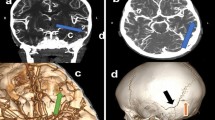Summary
A 63-year-old drunken man fell and hit his head on the ground. Apart from symptoms of alcoholisation no signs of severe injuries were found. The man died\(2{\raise0.5ex\hbox{$\scriptstyle 1$}\kern-0.1em/\kern-0.15em\lower0.25ex\hbox{$\scriptstyle 2$}}\) days after the accident. The autopsy revealed a huge fracture system in the right parietal region. A branch of the medial cerebral artery was stretched between the cortex and one of the fracture lines, passing through a tear in the dura. Characteristics of this case were that no larger hemorrhage was found and the artery which was torn from the cortex showed no lesions. The case also indicates the immense relative movements between skull and brain which occur during such trauma.
Zusammenfassung
Ein 63jähriger Alkoholiker stürzt in betrunkenem Zustand im Treppenhaus. Auf der Rettungsteile ist der Mann schläfrig aber bei Bewußtsein; es werden neben der Alkoholisierung keine gravierenden Verletzungen festgestellt, Röntgenaufnahmen des Schädels verwackeln. Übernachtung in Polizeigewahrsam (GeSa), am nächsten Morgen zu Fuß nach Hause, dort über 2 Tage Eintrübung, Nausea, Erbrechen.\(2{\raise0.5ex\hbox{$\scriptstyle 1$}\kern-0.1em/\kern-0.15em\lower0.25ex\hbox{$\scriptstyle 2$}}\) Tage nach dem Sturz von Ehefrau leblos im Bett aufgefunden. Obduktion: Oberfl. Schürfung Kopfhaut re. parietal, darunter Blutungen in der Galea und re. M. temp.; ausgedehntes Bruchsystem re. Parietalregion. Ein Ast der re. A. cerebri media war durch einen Riß der Dura ziehend zwischen Cortex und einer der Frakturlinien aufgespannt. Intracranielle Blutungen konnten ebenso wie Verletzungen der Arterie selbst nicht beobachtet werden. Der Fall ist erneut ein Indiz für die großen Relativbewegungen zwischen Gehirn und Schädel bei derartigen Traumen.
Similar content being viewed by others
References
Courville CB (1961) Forensic neuropathology. I. Introduction — technical matters. J Forensic Sci 6:445–468
Courville CB (1962) Forensic neuropathology. 11. Mechanisms of craniocerebral injury and their medicolegal significance. J Forensic Sci 7:1–28
Dirnhofer R, Sigrist T (1977) Chronisches subdurales Hämatom nach Schleudertrauma. In: Schneider V (ed) Festschrift W. Krauland. Zentrale Universitätsdruckerei, Berlin, pp 103–120
Hey R (1925) Subdurales Hämatom als Sportverletzung. Dtsch Z Gesamte Gerichtl Med 5:12–16
Krauland W (1982) Verletzungen der kortikalen Schlagadern, subdurale Blutung. In: Krauland W (ed) Verletzungen der intrakraniellen Schlagadern. Springer, Berlin Heidelberg New York, pp 177–234
Sehneider V (1970) Traumatische Aneurysmen der Schlagadern an der Mantelfläche des Großhirns und ihre Beziehungen zu subduralen Blutungen. Monatsschr Unfallheilk 73:63–69
Vance BM (1950) Ruptures of surface blood vessels on cerebral hemispheres as a cause of subdural hemorrhage. Arch Surg 61:992–1006
Werkgartner A (1922) Subdruale Blutungen aus verborgener Quelle. Beitr Gerichtl Med 5:191–211
Author information
Authors and Affiliations
Rights and permissions
About this article
Cite this article
Rothschild, M.A. An interesting case of arterial trauma after craniocerebral injury. Int J Leg Med 104, 49–53 (1990). https://doi.org/10.1007/BF01816485
Received:
Revised:
Issue Date:
DOI: https://doi.org/10.1007/BF01816485




